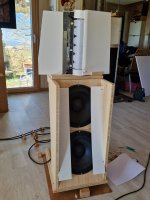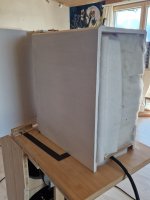Say you have a driver area of 100 with an Xmax of 2 = VD 200. (VD is volume displacement and Xmax is the max amount of movement from the voice coil)It's clear to me what you're writing. Larger rubanoids go deeper, but why?
With a driver area of 200 you got the same result with an Xmax of 1 that's also VD 200.
So bigger area result in a lower Xmax.
Lets say the rubanoide Xmax is fixed at 1 then you need to increase the driver area to go lower.
That's because it's the sum of Driver area times Xmax = VD
And to go lower you need more VD for the same amount of dB.
Rob
Okay Rob, this has been described differently in this topic. Of course, a lot of things can be manipulated with a crossover. Thank you very much. My question about the copper cap has not yet been answered. It's not about using it or not, but does this copper cap have to be electrically insulated from the pole plate?
Also , ruba2 has a lower fs due to double diafram mass then the others, when same materials are used in both.So again my question: Why does the ruba1 and 1/1 ruba (25cm) only run on 500 hz/ -3 db The ruba2 (50cm) on 300 Hz-3db ?
Mass in relation to the strength of the drive. Weak drive equals lower fs. The diaphragm shape of the ruba, together with the single-sided drive, is a problem of little movement and little draft. Increasing the mass of the same membrane brings little. High frequencies also suffer from this. Fs the rubanoid is usually very deep.
Great entertainment seeing the video of construction.
But all kinds of things are unknown about the linearity, hysteresis, and so on of the gap and of that sheet of ordinary household plastic which supplies the restoring force.
A simple matter to test distortion and other parameters.
But all kinds of things are unknown about the linearity, hysteresis, and so on of the gap and of that sheet of ordinary household plastic which supplies the restoring force.
A simple matter to test distortion and other parameters.
Why is my name in there ? not even sure what i am looking at, what video was that. im sure it had to to with the black paper i usedFinally found the curves that contradict the answers given. Lengthening the membrane leads to more depth. If this had to do with x.max, then the curves would also have to be apart at 1000 Hz? But it could also be that I'm too stupid.
greetings View attachment 1294892
but what did i proof ? without knowing >?
Last edited:
- Home
- Loudspeakers
- Planars & Exotics
- A DIY Ribbon Speaker of a different Kind

